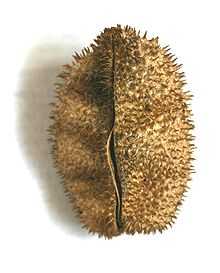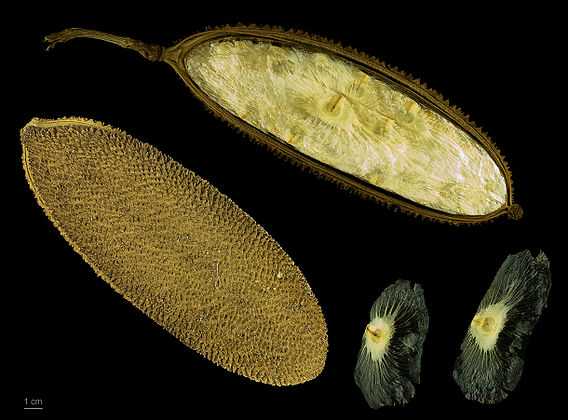Pithecoctenium
| Pithecoctenium | |
|---|---|
 | |
| fruit of Pithecoctenium sp. | |
| Scientific classification | |
| Kingdom: | Plantae |
| (unranked): | Angiosperms |
| (unranked): | Eudicots |
| (unranked): | Asterids |
| Order: | Lamiales |
| Family: | Bignoniaceae |
| Genus: | Pithecoctenium |
| Species | |
|
About 20, see text | |
Pithecoctenium is a Bignoniaceae genus of some 20 species of climbing shrubs occurring in the Caribbean and Tropical South America from Brazil to Mexico. Leaves are opposite with 3 entire and stalked leaflets, the terminal leaflet sometimes being modified into a tendril. The genus has distinctive prickly capsules.[1] The white or violet flowers are in simple racemes, sometimes branched. The genus is closely related to Bignonia and Anemopaegma.
Pithecoctenium crucigerum (L.) A.H. Gentry has become an invasive weed in Australia.[2] Chemical investigation of methanol extracted from this species yielded the iridoid glycoside theviridoside along with five phenylethanoid glycosides (verbascoside, isoverbascoside, forsythoside B, jionoside D and leucosceptoside B), these last all active against DPPH.[3]
'Pithecoctenium' translates to 'Monkey Comb'.
Species
- Pithecoctenium carolinae
- Pithecoctenium crucigerum
- Pithecoctenium cynanchoides
-

Pithecoctenium crucigerum -

Pithecoctenium cynanchoides
References
- ↑ Dictionary of Gardening - Royal Horticultural Society (1956)
- ↑ http://www.backyardnature.net/mexnat/monkcomb.htm
- ↑ "Iridoid glycosides from the stems of Pithecoctenium crucigerum (Bignoniaceae)". Phytochemistry 68 (9): 1307–11. May 2007. doi:10.1016/j.phytochem.2007.02.002. PMID 17382978.
External links
| Wikispecies has information related to: Pithecoctenium |